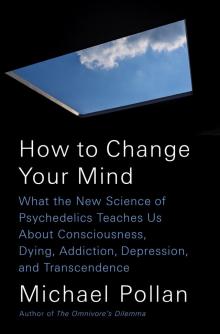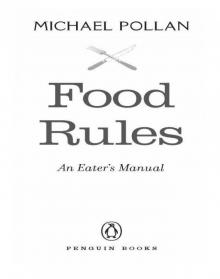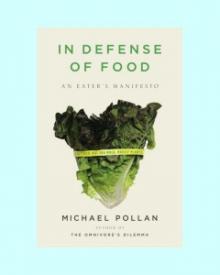- Home
- Michael Pollan
In Defense of Food Page 8
In Defense of Food Read online
Page 8
Even a cursory examination of the study’s methods makes you wonder what, if anything, it proved, either about dietary fat or meat eating. You could argue that, like the Nurses’ Healthy Study, all any such trials prove is that changing one component in the diet at a time, and not by much, does not confer a significant health benefit. But perhaps the strongest conclusion that can be drawn from an analysis of the Women’s Health Initiative is about the inherent limitations of this kind of nutrient-by-nutrient nutrition research.
Even the beginning student of nutritionism will immediately spot several flaws: The focus was on dietary fat rather than on any particular food, such as meat or dairy. So women could reach their goal simply by switching to lower-fat animal products. Also, no distinctions were made between different types of fat: Women getting their allowable portion of fat from olive oil or fish were lumped together with women getting their fat from low-fat cheese or chicken breasts or margarine. Why? Because when the study was designed sixteen years ago, the whole notion of “good fats” was not yet on the mainstream scientific scope. Scientists study what scientists can see.
Another problem with the trial was that the low-fat group failed to hit the target of reducing their fat intake to 20 percent of total calories. The best they could manage was 24 percent in the first year, but by the end of the study they’d drifted back to 29 percent, only a few percentage points lower than the control group’s fat intake. Which was itself drifting downward as the women allowed to eat as much fat as they wanted presumably read the newspapers and the food product labels and absorbed the culture’s enthusiasm for all things low fat. (This corruption of a control group by popular dietary advice is called the treatment effect.) So it’s hardly surprising that the health outcomes of the two groups would not greatly differ-by the end, they might have been consuming pretty much the same diet.
I say “might have been” because we actually have little idea what these women were really eating. Like most people asked about their diet, they lied about it-which brings us to what is perhaps the single biggest problem in doing nutrition science. Even the scientists who conduct this sort of research conduct it in the knowledge that people underestimate (let’s be generous) their food intake all the time. They have even developed scientific figures for the magnitude of the error. “Validation studies” of dietary trials like the Women’s Health Initiative or the Nurses’ Study, which rely on “food-frequency questionnaires” filled out by subjects several times a year, indicate that people on average eat between a fifth and a third more than they say they do on questionnaires.* How do the researchers know that? By comparing what people report on their food-frequency questionnaires with interviews about their dietary intake over the previous twenty-four hours, thought to be somewhat more reliable. Somewhat. Because as you might expect, these “twenty-four-hour recall” data have their own accuracy problems: How typical of your overall diet is what you ate during any single twenty-four-hour period?
To try to fill out the food-frequency questionnaire used by the Women’s Health Initiative, as I recently did, is to realize just how shaky the data on which all such dietary studies rely really are. The survey, which takes about forty-five minutes to complete, starts off with some relatively easy questions. “Did you eat chicken or turkey during the last three months?” Having answered yes, I then was asked, “When you ate chicken or turkey, how often did you eat the skin?” And, “Did you usually choose light meat, dark meat, both?” But the survey soon became harder, as when it asked me to think back over the past three months to recall whether when I ate okra, squash, or yams were they fried, and if so, were they fried in stick margarine, tub margarine, butter, shortening (in which category they inexplicably lumped together hydrogenated vegetable oil and lard), olive or canola oil, or nonstick spray? I would hope they’d take my answers with a grain of salt because I honestly didn’t remember and in the case of any okra eaten in a restaurant, even a hypnotist or CIA interrogator could not extract from me what sort of fat it was fried in. Now that we spend half of our food dollars on meals prepared outside of the home, how can respondents possibly know what type of fats they’re consuming?
Matters got even sketchier in the second section of the survey, when I was asked to specify how many times in the last three months I’d eaten a half-cup serving of broccoli, among a dizzying array of other fruits and vegetables I was asked to tally for the dietary quarter. I’m not sure Marcel Proust himself could recall his dietary intake over the last ninety days with the sort of precision demanded by the FFQ.
When you get to the meat section, the portion sizes specified haven’t been seen in America since the Hoover administration. If a four-ounce portion of steak is considered “medium,” was I really going to admit that the steak I enjoyed on an unrecallable number of occasions during the past three months was probably the equivalent of two or three (or in the case of a steak house steak, no fewer than four) of these portions? I think not. In fact, most of the “medium serving sizes” to which I was asked to compare my own consumption made me feel like such a pig that I badly wanted to shave a few ounces here, a few there. (I mean, I wasn’t under oath or anything.)
These are is the sort of data on which the largest questions of diet and health are being decided today. “The most intellectually demanding challenge in the field of nutrition,” as Marion Nestle writes in Food Politics, “is to determine dietary intake.” The uncomfortable fact is that the entire field of nutritional science rests on a foundation of ignorance and lies about the most basic question of nutrition: What are people eating? Over lunch, I asked Nestle if I was perhaps being too harsh. She smiled.
“To really know what a person is eating you’d have to have a second invisible person following them around, taking photographs, looking at ingredients, and consulting accurate food composition tables, which we don’t have.” When you report on an FFQ that you ate a carrot, the tabulator consults a U.S. Department of Agriculture database to determine exactly how much calcium or beta-carotene that carrot contained. But because all carrots are not created equal, their nutrient content varying with everything from the variety planted and type of soil it was planted in to the agriculture system used (organic? conventional?) and the carrot’s freshness, these tables suffer from their own inaccuracies.
I was beginning to realize just how much suspension of disbelief it takes to be a nutrition scientist.
“It’s impossible,” Nestle continued. “Are people unconsciously underestimati
ng consumption of things they think the researcher thinks are bad or overestimating consumption of things they think the researcher thinks are good? We don’t know. Probably both. The issue of reporting is extraordinarily serious. We have to ask, How accurate are the data?”
It’s not as though the epidemiologists who develop and deploy FFQs are unaware of their limitations. Some of them, like Walter Willett, strive heroically to repair the faulty data, developing “energy adjustment” factors to correct for the fact that the calories reported on surveys are invariably wrong and complicated “measurement error” algorithms to fix the errors in the twenty-four-hour recall surveys used to fix the errors in the FFQ.
I tracked down Gladys Block, the prominent epidemiologist who developed the FFQ on which the Women’s Health Initiative based its own questionnaire. We met for coffee in Berkeley, where she is a professor in the School of Public Health. Nearing retirement, Block is unusually thoughtful about the limits of her field and disarmingly candid. “It’s a mess,” she said, speaking not of the FFQ itself but of the various formulae and algorithms being used to correct errors in the data. “Because if the energy [i.e., the reported calorie consumption] is off, then the nutrients are off too. So if you’re going to correct for calories, do you then also correct for…” She paused and then sighed. “No, it’s a mess.”
Block thinks the problem with nutrition science, which she feels “has led us astray,” is not the FFQ itself but mis-and overinterpretation of the data derived from the FFQ, a tool for which she makes realistic but strikingly modest claims: “The real purpose of the FFQ is to rank people” on their relative consumption of, say, fruits and vegetables or total calories. “If someone reports consuming five hundred calories a day, that’s not true, obviously, but you can say they’re probably at the low end of the spectrum. People overworry about accuracy.”
This was not the sort of thing I expected to hear from an epidemiologist. But then neither was this: “I don’t believe anything I read in nutritional epidemiology anymore. I’m so skeptical at this point.”
TEN - NUTRITIONISM’S CHILDREN
S o where does this leave us eaters? More confused about how to eat than any people in history, would be my strictly unscientific conclusion. Actually, there is some science, admittedly a little soft, which has captured a bit of the confusion that the supposedly harder science of nutrition has sown in the American mind. Paul Rozin is a psychologist at the University of Pennsylvania who has dreamed up some of the more imaginative survey questions ever asked of American eaters; the answers he’s collected offer a pretty good index to our current befuddlement and anxiety about eating. He has found, for example, that half of us believe high-calorie foods eaten in small amounts contain more calories than low-calorie foods eaten in much larger amounts. And that a third of us believe that a diet absolutely free of fat-a nutrient, lest you forget, essential to our survival-would be better for us than a diet containing even just “a pinch” of it. In one experiment, he showed the words “chocolate cake” to a group of Americans and recorded their word associations. “Guilt” was the top response. If that strikes you as unexceptional, consider the response of the French eaters to the same prompt: “celebration.” (Oh, yeah.) I think of Rozin as a kind of psychoanalyst of nutritionism.
A few years ago, Rozin presented a group of Americans with the following scenario: “Assume you are alone on a desert island for one year and you can have water and one other food. Pick the food that you think would be best for your health.”
The choices were corn, alfalfa sprouts, hot dogs, spinach, peaches, bananas, and milk chocolate. The most popular choice was bananas (42 percent), followed by spinach (27 percent), corn (12 percent), alfalfa sprouts (7 percent), peaches (5 percent), hot dogs (4 percent), and milk chocolate (3 percent). Only 7 percent of the participants chose one of the two foods that would in fact best support survival: hot dogs and milk chocolate.
Evidently some of the wreckage of the lipid hypothesis has washed up on Rozin’s desert island.
“Fat,” he writes, “seems to have assumed, even at low levels, the role of a toxin” in our dietary imaginations. I wonder why. As Rozin points out, “Worrying so much about food can’t be very good for your health.” Indeed. Orthorexia nervosa is an eating disorder not yet recognized by the DSM-IV, but some psychologists have recently suggested that it’s time it was. They’re seeing more and more patients suffering from “an unhealthy obsession with healthy eating.”
So this is what putting science, and scientism, in charge of the American diet has gotten us: anxiety and confusion about even the most basic questions of food and health, and a steadily diminishing ability to enjoy one of the great pleasures of life without guilt or neurosis.
But while nutritionism has its roots in a scientific approach to food, it’s important to remember that it is not a science but an ideology, and that the food industry, journalism, and government bear just as much responsibility for its conquest of our minds and diets. All three helped to amplify the signal of nutritionism: journalism by uncritically reporting the latest dietary studies on its front pages; the food industry by marketing dubious foodlike products on the basis of tenuous health claims; and the government by taking it upon itself to issue official dietary advice based on sketchy science in the first place and corrupted by political pressure in the second. The novel food products the industry designed according to the latest nutritionist specs certainly helped push real food off our plates. But the industry’s influence would not be nearly so great had the ideology of nutritionism not already undermined the influence of tradition and habit and common sense-and the transmitter of all those values, mom-on our eating.
Now, all this might be tolerable if eating by the light of nutritionism made us, if not happier, then at least healthier. That it has failed to do. Thirty years of nutritional advice have left us fatter, sicker, and more poorly nourished. Which is why we find ourselves in the predicament we do: in need of a whole new way to think about eating.
Part II - THE WESTERN DIET AND THE DISEASES OF CIVILIZATION
ONE - THE ABORIGINE IN ALL OF US
I n the summer of 1982, a group of ten middle-aged, overweight, and diabetic Aborigines living in settlements near the town of Derby, Western Australia, agreed to participate in an experiment to see if temporarily reversing the process of westernization they had undergone might also reverse their health problems. Since leaving the bush some years before, all ten had developed type 2 diabetes; they also showed signs of ins
ulin resistance (when the body’s cells lose their sensitivity to insulin) and elevated levels of triglycerides in the blood-a risk factor for heart disease. “Metabolic syndrome,” or “syndrome X,” is the medical term for the complex of health problems these Aborigines had developed: Large amounts of refined carbohydrates in the diet combined with a sedentary lifestyle had disordered the intricate (and still imperfectly understood) system by which the insulin hormone regulates the metabolism of carbohydrates and fats in the body. Metabolic syndrome has been implicated not only in the development of type 2 diabetes, but also in obesity, hypertension, heart disease, and possibly certain cancers. Some researchers believe that metabolic syndrome may be at the root of many of the “diseases of civilization” that typically follow a native population’s adoption of a Western lifestyle and the nutrition transition that typically entails.
The ten Aborigines returned to their traditional homeland, an isolated region of northwest Australia more than a day’s drive by off-road vehicle from the nearest town. From the moment they left civilization, the men and women in the group had no access to store food or beverages; the idea was for them to rely exclusively on foods they hunted and gathered themselves. (Even while living in town, they still occasionally hunted traditional foods and so had preserved the knowledge of how to do so.) Kerin O’Dea, the nutrition researcher who designed the experiment, accompanied the group to monitor and record its dietary intake and keep tabs on the members’ health.

 A Place of My Own: The Education of an Amateur Builder
A Place of My Own: The Education of an Amateur Builder Cooked: A Natural History of Transformation
Cooked: A Natural History of Transformation The Omnivore's Dilemma
The Omnivore's Dilemma How to Change Your Mind
How to Change Your Mind Food Rules
Food Rules In Defense of Food
In Defense of Food A Place of My Own
A Place of My Own